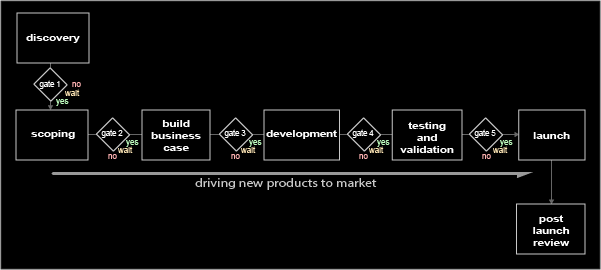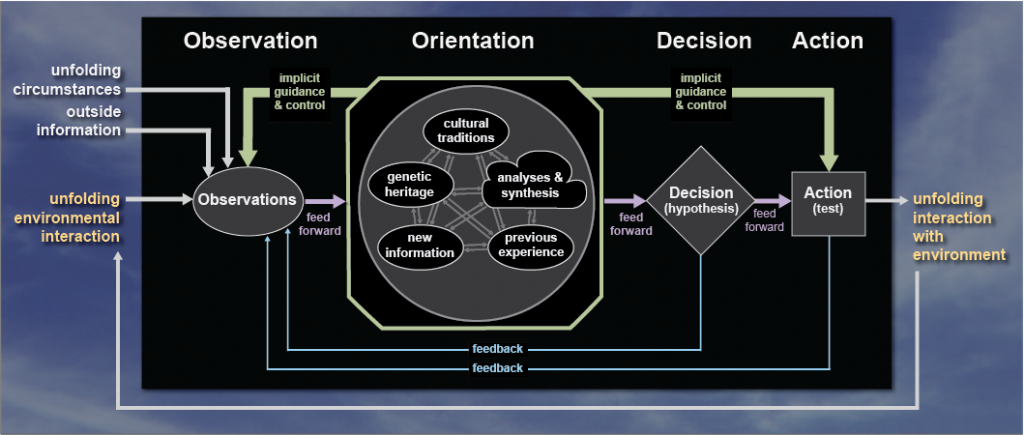The greatest value of producing interactive prototypes can be the impact on the network developing new products. In some development environments, this value may not be communicated as a primary objective.
Sequential Development Processes
Some textbooks summarize the steps to new product development (NPD) as a sequential process:
- Select one idea from a large list of possibilities
- Scope the project. Develop a plan that includes estimates to transition from an idea to a complete new product
- Craft a business case or business model
- Develop the product. These development activities are typically done by individuals in roles such as scientist, engineer, coder, tester, marketer, subject matter expert, project manager, product manager, …)
- Test the product internally
- Produce high fidelity prototypes
- Place prototypes with potential customers for external test
- Craft a marketing communications package
- Launch the product to the intended market

A phased-gate approach to new product development is characterized by a sequential process used to manage projects
Often, this approach is administered by:
- A formal management process such as a Stage-Gate® process
- A resource management process that includes a list of requirements for specific project roles
- Other explicit processes, checklists, procedures, and practices
Often, when Agile or Lean concepts are introduced, the impact is limited to the day-to-day activities of development.
Common Uses of Prototypes in New Product Development
There are many kinds of prototypes associated with a sequential product development process.
Some prototypes are produced quickly. They are used to evaluate a few design parameters. Typically, these prototypes are discipline specific. Artists sketch. Electrical engineers breadboard. Designers wireframe. Marketers test messages with focus groups. Typically, these prototypes are produced early in the development effort. Often, the process of designing and building these prototypes enhances the capabilities of the functional specialists that produce them. The raw data from testing these prototypes remains within a small group of like-minded specialists. In many cases, an interpretation of the test results is summarized in reports that are distributed to other specialists and managers.
Other prototypes are produced in limited quantities near the end of the development process. The construction of these high-fidelity prototypes requires the integration of components from multiple functional disciplines. Since the prototypes are constructed prior to the market launch, the potential for changing the product is minimized. Often, the major reasons for the production of high fidelity prototypes are:
- Test the integration of components developed by separate groups of specialists
- Gather testimonials for use in the market launch
- Use for compliance testing (such as electrical safety, crash testing, drop testing,…)
- Forecast production problems
Other names for these prototypes include alpha-units or beta units.
Typical Benefits of Interactive Prototypes
Prototypes can be static or interactive. Typically, interactive prototypes can provide insights that a static prototypes can not. For example, instead of a designer producing static sketches of web pages, the prototype could be designed and developed in HTML and CSS. Instead of asking someone to evaluate the aesthetics of sketches, evaluators interact with dynamic prototypes to perform tasks and solve simulated problems.
Dynamic prototypes have the potential to provide valuable feedback. Since the feedback loop from the evaluator to the designer is faster, the potential for misinterpretation of the evaluator’s comment by the designer is minimized. The potential to detect mismatches (what the designer believed that the customer wanted and what the customer needs) is maximized.
When evaluators interact with prototypes, deficiencies are revealed. Individual contributors are presented with an opportunity to fix their mistakes and learn from the experience. When the testing efforts focus on product functions, prototype testing tends to impact individual contributors. Individual learning is associated with this testing.
Typically, interactions with prototypes impact an individual contributor’s orientation (the way they approach the challenges of development).
Typically, the primary benefits associated with the testing of interactive prototypes are associated with the potential to improve user experience (UX).
Unexpected Benefits
The value of producing interactive prototypes can go beyond generating user experience data. The greatest value can be the impact on the network developing the new product.

Individuals with enhanced capabilities in a new product development network are indicated by the difference in color and size. The white-colored field that surrounds these two individuals indicates better interactions between these contributors.
When the development of interactive prototypes involves many individuals from diverse specialties, it changes the way the network approaches development. When individuals from different perspectives (such as engineering and marketing) work together to develop an abundant number of interactive prototypes, the benefits include:
- New opportunities for cooperation, collaboration, and harmony
- Reduction of the innovation gap (the time from an idea to value creation)
Fewer tasks must be defined explicitly. Tacit knowledge is developed. The construction and maintenance of To-Do lists can be minimized because corrections are more likely to be made in real-time instead of adding items to a backlog for processing at a later time. The network becomes more cohesive. Appreciation of other perspectives improves. Situational awareness improves. The ability of the network to adapt improves. Network agility improves. The orientation of the network becomes more implicit. The potential for innovation improves.
When interactive, holistic prototypes are built and evaluated frequently throughout the development effort, the unexpected benefits include realtime improvements to feedback, feed forward, and implicit guidance and control proficiencies throughout the network.

OODA Loop sketch that includes feedback, feed forward, and implicit guidance & control. Based on a 1995 sketch by John Boyd.
As the development capabilities of the network are enhanced, the development approach becomes more recursive, the Development Experience [DX] for improves, and the probability of project innovation is maximized.
An improved potential for innovation is compounded. It can span the current project, the next project, and adjacent projects. Individuals retain enhanced capabilities for future development projects with other networks.
Endnotes
This post included extracts from the book “Developing Winners: Assimilating the Insights Encapsulated in Boyd’s OODA Loop” by OpLaunch founder, Mark A Hart.
 The Unexpected Benefit of Interactive Prototypes in New Product Development [ 8:43 ] Play Now | Play in Popup | Download
The Unexpected Benefit of Interactive Prototypes in New Product Development [ 8:43 ] Play Now | Play in Popup | Download
